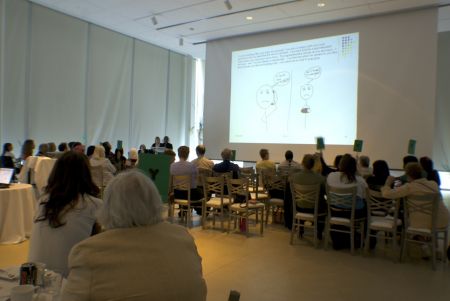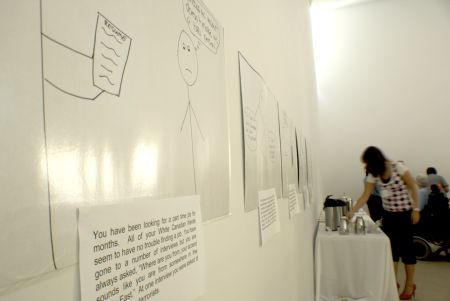You always wear a hijab (a traditional head covering worn by Muslim women). On your first day of work at a coffee shop, the owner says you have to take it off because everyone wears a company baseball cap. Would you consider this a case of discrimination?
What about this? You and your friends are having a great time at the mall, laughing and having fun. You notice that a security guard is close by and is watching all of you. You also notice that other white kids are doing the same thing, but the security guard only asks you and your friends to leave because you are making too much noise. You and your friends are Asians.
At the Community Forum hosted by Hamilton's Community Legal Clinics on 24 Sep. at the Art Gallery of Hamilton, two speakers, Sharmaine Hall and Lesley Brook from the Toronto based Human Rights Legal Support Centre (HRLSC) opened the forum with these scenarios, asking the audience to decide whether they are cases of discrimination.
The audience had two choices: to raise a red sign to indicate "no” or a green one to indicate "yes." For the two scenarios above? Unanimously yes.
The new Ontario human rights system is in full effect since 30 Jun. 2008. The Forum was opened to anyone who wanted to find out how the new system is working, what kinds of discrimination are being reported, and what resources are available to those with complaints.
Last year, "more voices called for social and economic status and gender identity to be treated as essential human rights." The new structure was put in place to meet these new challenges and continues to battle against age, gender, and racial discrimination.
As of 30 Dec. 2008, the Ontario Human Rights Commission (OHRC) is a three-pillared system, which consists of Human Rights Tribunal of Ontario (HRTO), OHRC, and Human Right Legal Support Centre (HRLSC).
Under the new structure, all applications are now filed directly at the Tribunal, rather than at the Commission. This new approach greatly reduced the workforce at the Commission, which allows them to shift their focus from processing and litigating cases, to promoting, protecting, and advancing human rights.
For applicants, the change cuts down processing time. Sharmaine Hall, a former advisor at Dundurn Community Legal Services in Hamilton, now the Executive Director at HRLSC, shared that cases could take as long as six years to resolve under the old system. Now, applications usually reach a final disposition within a year from the time it is filed.
The new structure also includes the creation of the Human Rights Legal Support Centre, a new agency that provides free legal assistance to people who have been discriminated against and want to file an application at the Human Rights Tribunal of Ontario.
"One of the benefits is that here at the [Legal Support] Centre, we are able to provide early intervention—that is, a quick telephone call or letter to an employer, landlord or service provider to alert them that they are violating Ontario’s Human Rights Code and may face an application at the Tribunal," said a legal advisor from HRLSC who insisted on remaining anonymous.
She continued, "In many cases, we are able to quickly resolve the issue. For instance, we have had success in reinstating people fired for discriminatory reasons, or getting accommodation immediately for someone at their job."
According to the data provided the Legal Support Centre, 70 per cent of the issues at the Centre were settled by early intervention or assistance provided on an urgent basis.
One of the Centre's first resolved cases of early intervention involved a woman who was sexually harassed at work by her employer. The centre was able to reach a good monetary settlement for her, get the company to agree to extensive training on human rights issues, and have the employer donate money to a women’s shelter—all these without filing an application at the Tribunal.
“The calls that are the most memorable to me are the calls from people about who know in their guts that something is wrong and are standing up for their rights for the first time,” the Advisor shared further. "Whether it is a person with a service dog being denied entry, or a woman being fired because she is pregnant, or the overtly racist behaviour of an employer—I sometimes find it hard to believe that this is still happening."
Under the Ontario Human Rights Code, there are five areas of discrimination: employment; housing; contracts; services, goods and facilities; and unions or occupational/professional associations. Last year in Hamilton, 84 per cent of discriminations were filed under employment, 12 per cent under services, goods and facilities, and the remaining 4 per cent under housing.
Every person has a right to equal treatment in these five areas according to the Code regardless of “race, ancestry, place of origin, colour, ethnic origin, citizenship, creed, sex, sexual orientation, age, marital status, family status, or disability." Any discrimination committed on any of these grounds is a violation against the code.
Last year in Hamilton, 55 per cent of the cases of discrimination were committed against those with disabilities. A trailing 22 per cent of discrimination cases against sex, 13 per cent against race, and the rest, were divided among age, ancestry, and family status. Ontario shows a similar trend in both areas and grounds of discrimination.
“People do not stand up against discrimination because they think that they need financial resources to do so,” legal advisor Lesley Brook said during the presentation, "but all the services provided are free,” Unless the “discrimination” is not under the code.
Valerie, one of the participants at the Forum, suggested that learning disability, which is not yet recognized as a discrimination issue, should be added to the Ontario Human Rights Code.
“People have been abused and get beaten up by the society,” said Valerie, who suffers from learning disabilities and has tried to get help from legal clinics but failed.
She also tried to get help from institutions like Arrowsmith School in Toronto, a privately owned school which is dedicated to helping students with learning disabilities, but the cost is too high and unaffordable by many.
“People see us as drains of public pursuit,” Valerie continued, “We are being discriminated against because of able-ism.”
For anyone who has questions and concerns like Valerie, the best approach is to contact the community legal clinic directly. Information regarding human rights and legal assistance is available on Ontario Human Rights Legal Support Centre's website.

